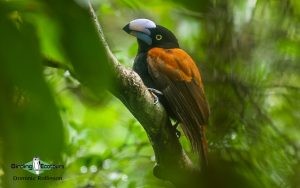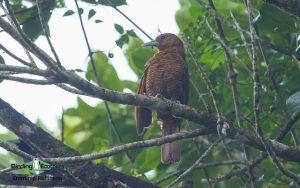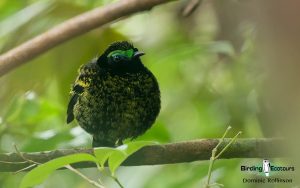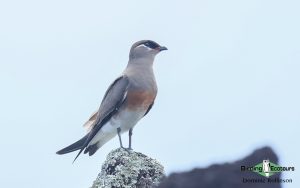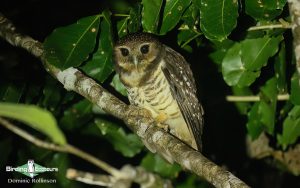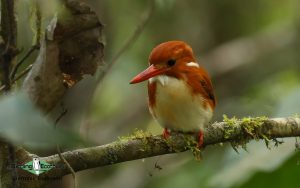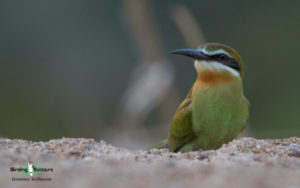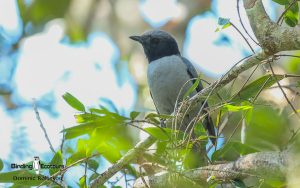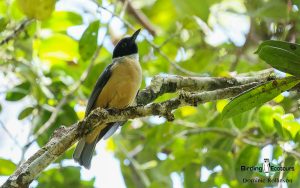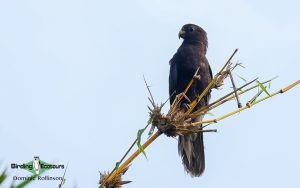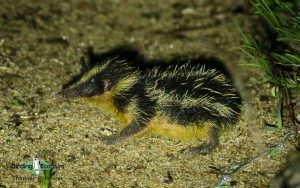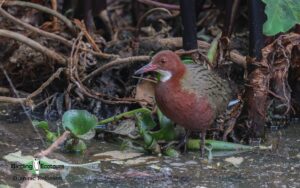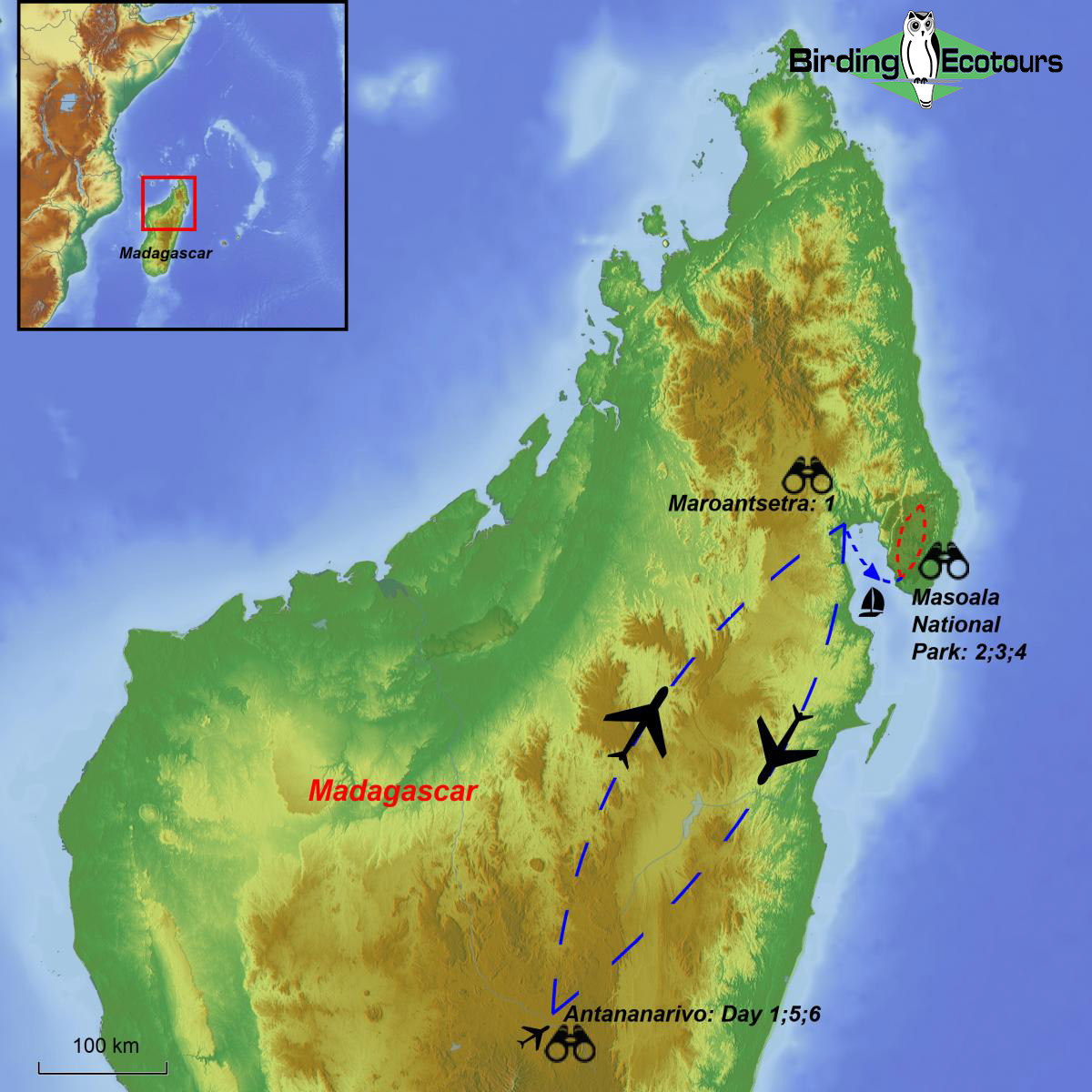Birding Tour Madagascar: 6-day Masoala Peninsula Extension
Madagascar Birding Tour: 6-day Masoala Peninsula Extension
October/November 2025/2026
This Masoala Peninsula birding tour visits the largest intact lowland rainforest in all of Madagascar. Due to its geographical separation, and deforestation in areas surrounding the peninsula, it means several species of rare and exotic wildlife are now restricted to Masoala Peninsula. The area is surely one of the continent island’s least disturbed and beautiful areas, with untouched rainforest sweeping right down to clean, white-sand beaches. The lodge that we stay in on Masoala Peninsula is right on the edge of the rainforest and we often wake up to the calls of Greater Vasa and Lesser Vasa Parrots and fall asleep to the sounds of Rainforest Scops and White-browed Owls. Of course the highlight of any Masoala Peninsula birding tour will likely be the unbelievable Helmet Vanga (of which we have an excellent chance of seeing) as well as the even more range-restricted and rare Bernier’s Vanga. Further tricky species, which are easier here than anywhere else on the main Madagascar birding circuit, include Brown Mesite, Scaly and Short-legged Ground Rollers and Madagascar Pratincole.
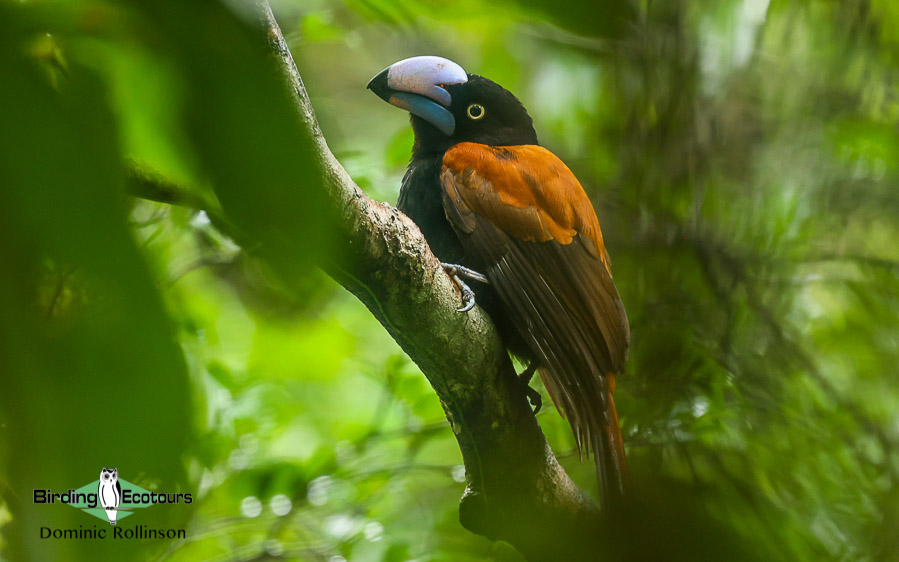
Masoala Peninsula supports several rare and range-restricted lemur species such as Red Ruffed, White-fronted, Seal’s Sportive, Masoala Fork-marked and Moore’s Woolly Lemur. The lowland rainforests of Masoala are also home to good numbers of the largest, and most bizarre nocturnal lemur, the Aye-aye, although sightings of this most-wanted lemur are far from guaranteed.
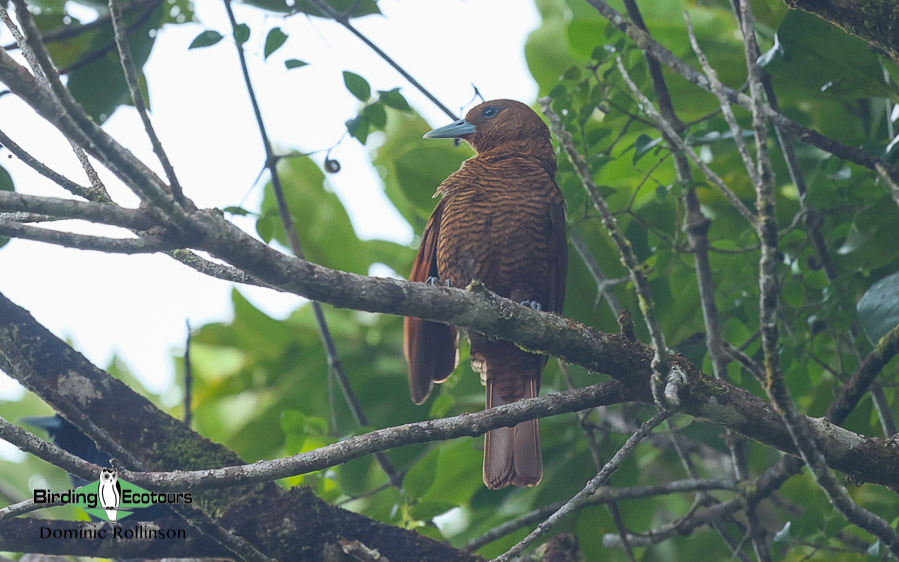
Itinerary (6 days/5 nights)
Day 1. Flight to Maroantsetra
We fly to Maroantsetra and transfer to our hotel. Birding around the hotel grounds is unfortunately very limited and besides Crested Drongo, Malagasy Coucal, and Malagasy Palm Swift, we’re unlikely to see too much else. A short walk to the nearby estuary may however produce some water birds such as Purple and Striated Herons, White-fronted Plover, Greater Crested and Lesser Crested Terns, Eurasian Whimbrel, and Common Sandpiper. In the evening we will however look for the striking and cute Lowland Streaked Tenrec which is fairly reliable around the lodge grounds at night.
Overnight: Masoala Resort, Maroantsetra
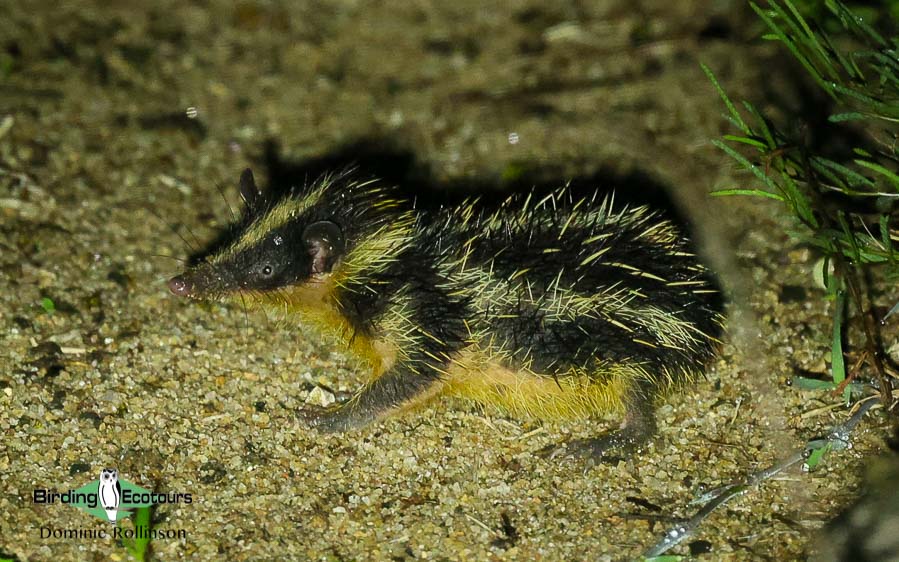
Day 2. Boat transfer to Masoala National Park
Today we will take a boat trip across Antongil Bay, Madagascar’s largest bay. We travel past the island of Nosy Mangabe and eventually reach the Masoala Peninsula, which contains Madagascar’s largest tract of lowland rainforest and its largest national park, in the form of Masoala National Park. The boat crossing is normally quiet bird wise however we may see Greater Crested and Roseate Terns.
On arrival, we will quickly unpack and head out onto the trails behind our ecolodge heading into the nearby rainforest where we can get started on our long list of targets. Some of the birds we will target in this section of the rainforest might include Brown Mesite, Blue Coua, Madagascar Spinetail, Madagascar Blue Pigeon, Velvet Asity, Red-tailed and Chabert Vangas, White-throated Oxylabes, Long-billed Bernieria, and many others. During our time in Masoala’s rainforests we will be on the lookout for Madagascar Ibis which quietly feed on the forest floor and are easily overlooked. In the early evening we might see Madagascar Pratincoles hawking insects overhead while the night sounds often include Rainforest Scops and White-browed Owls.
The best time for birding in the tropical lowland rainforests of Masoala Peninsula is during the mornings, with bird activity dropping off markedly in the afternoons. As such, our routine generally involves spending the entire morning out hiking and birding, then coming back for lunch and mostly taking the afternoons easy to bird around the lodge grounds (where Greater Vasa and Lesser Vasa Parrots may be seen, or perhaps the resident group of Eastern Lesser Bamboo Lemurs) or just enjoy the serene setting and perhaps a dip in the ocean.
In the evenings we can do a night walk or two where we may encounter various chameleon species and Seal’s Sportive and Moore’s Woolly Lemurs while the crème de la crème would be the rare and almost alien-looking Aye-aye.
Overnight: Ecolodge Chez Arol, Masoala
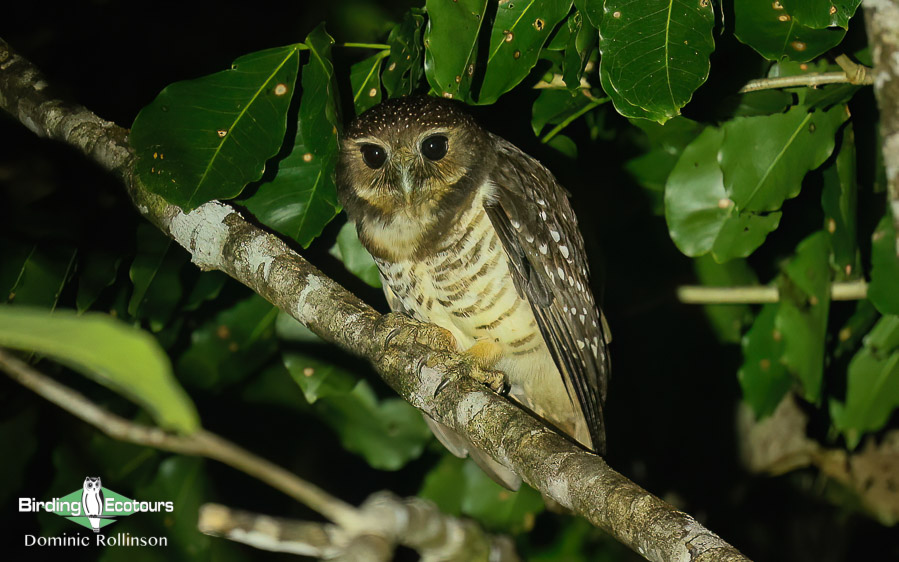
Days 3 – 4. Birding Masoala National Park
We bird the incredible forests and remote tropical beaches of Masoala National Park for some of Madagascar’s most awesome birds, including Helmet (top of our list of target birds), White-headed and Nuthatch Vangas, Red-breasted and Red-fronted Couas, Short-legged and Scaly Ground Rollers, Brown Mesite, Cuckoo-roller, and many other sought-after birds.
On one of these days we will visit another nearby section of Masoala National Park which protects a different type of forest habitat, this being the littoral forest which is less dense, has a much lower canopy and is dominated by pandanus palms. Here our primary target is the range-restricted and highly sexually dimorphic Bernier’s Vanga which is regualr here. Other species which are often easier to find (and get better views of) in this forest include Blue Vanga, Common Newtonia, Stripe-throated Jery, and Malagasy Green Sunbird. The coastal rock formations here often hold the tricky Madagascar Pratincole too.
Of course, we will be on the lookout for some incredible lemurs during our daytime birding hikes too and hope to find Red Ruffed and White-fronted Lemurs.
Overnight: Ecolodge Chez Arol, Masoala
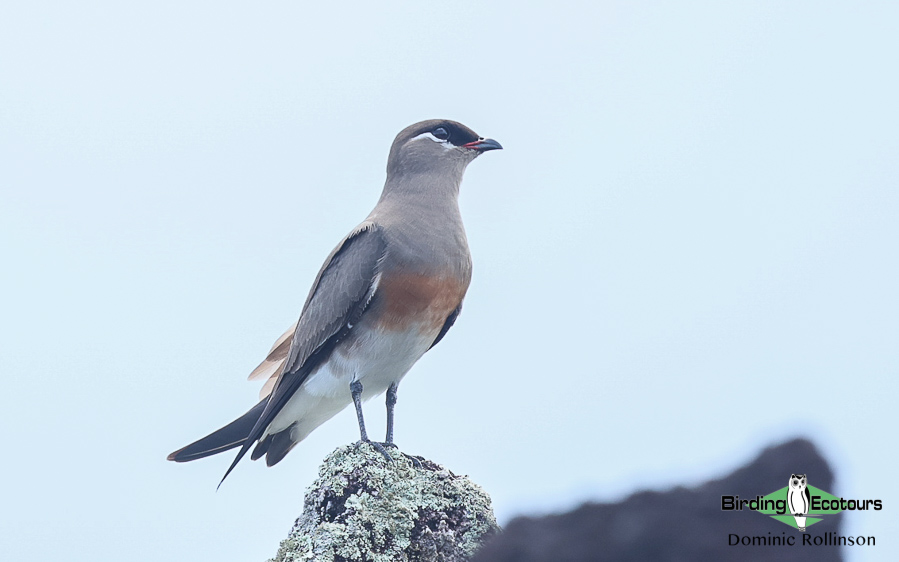
Day 5. Boat Transfer to Maroantsetra, flight to Antananarivo
Today our time on the beautiful Masaoala Peninsula ends and we return via our boat trip to Maroantsetra and from there fly to Antananarivo. Once back in Tana we will transfer to our hotel.
Overnight: Relais des Plateaux, Antananarivo
Day 6. Departure, or day 1 of main trip
Today either your international flight will leave for home or you will start on our Best of Madagascar main tour.
Please note that the itinerary cannot be guaranteed as it is only a rough guide and can be changed (usually slightly) due to factors such as availability of accommodation, updated information on the state of accommodation, roads, or birding sites, the discretion of the guides and other factors. In addition, we sometimes have to use a different international guide from the one advertised due to tour scheduling.
Download ItineraryBest of Madagascar: Birding and Mammal Trip Report, including Masoala Peninsula
26 September – 14 October 2022
By Dominic Rollinson
DOWNLOAD TRIP REPORT
Overview
Madagascar, the world’s fourth largest island, is home to a unique assortment of birds and other wildlife. For almost three weeks in October 2022, we explored this unique location, from the tropical rainforests of Masoala Peninsula in the northeast to the dry spiny forest of the southwest. Despite its proximity to Africa, Madagascar’s flora and fauna is vastly different, with many exciting endemic species and families, making it a must for any world birder. A birding trip to Madagascar, however, does not only concentrate on the many spectacular birds on offer. The island has a multitude of endemic lemurs, as well as many other exotic and bizarre wildlife, from cryptically camouflaged geckos, to outrageously designed insects.
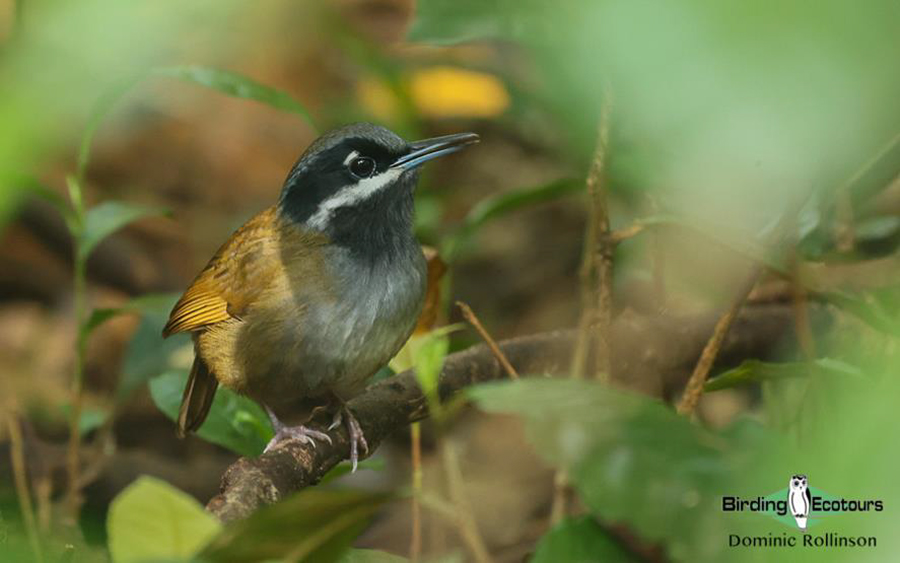
The unusual Crossley’s Vanga put a wonderful show on for us in the rainforests of Andasibe.
Madagascar’s site guides certainly deserve a special mention here: they went to huge efforts (with impressive patience) to show us the specials of their area. They were also incredibly helpful as they guided us along the many steep and slippery trails in the rainforests and traversed the hot and dry spiny forest of the southwest to find mesites and other special birds while we waited patiently in the shade of baobab trees. Madagascar’s policy of making site guides mandatory at each tourist and birding hotspot will surely help to ensure the long-term protection of these wildlife havens.
This two-week tour of eastern, central and southwestern Madagascar was combined with a five-day pre-trip to Masoala Peninsula, which most agreed was the absolute highlight, with its pristine rainforests reaching right down to the beaches and a peaceful, relaxed atmosphere, not to mention specials such as Helmet and Bernier’s Vangas. On this extensive tour of Madagascar, we saw all five species of ground rollers, all nine species of couas, 19 species of vangas and allies, four species of endemic owls, 14 species of lemurs and an assortment of chameleons and other bizarre reptiles. With special-mention to other birds including Velvet Asity, Common Sunbird-Asity, Madagascar Flufftail, Appert’s Tetraka and Madagascar Sandgrouse. Full species lists of birds, mammals, reptiles and amphibians are provided at the end of this report.
Detailed Report
Day 1, 26th September 2022. Antananarivo to Maroantsetra
All the clients had arrived in the days prior to the start of the trip and our flights were booked for mid-morning, however, a slight flight delay meant we only ended up leaving in the early afternoon. As such we had a relaxed morning around our comfortable Tana (Antananarivo) hotel and managed our first few Madagascar species in the form of Malagasy Bulbul, Malagasy White-eye, Malagasy Kestrel, Madagascar Mannikin and brief views of a Madagascar Hoopoe (for Mitch and Dom only).
We arrived in the northeastern town of Maroantsetra in the late afternoon and after a bumpy drive to our lodge we enjoyed a lovely meal, with the exciting prospect of Masoala Peninsula to look forward to the following morning. Before calling it a day, we wandered around the lodge grounds where we found a couple of cute and brightly colored Lowland Streaked Tenrecs as they went about their nocturnal activities.

The adorable Lowland Streaked Tenrec wandered around the lodge lawns in Maroantsetra.
Day 2, 27th September 2022. Maroantsetra to Masoala Peninsula
As was to be the theme for most of the trip, we were up early and enjoying breakfast before sunrise. Thereafter, we boarded the boats which would take us to Masoala Peninsula. We had to catch our boat ride in the early morning, as the winds picked up every afternoon, making the crossing dangerous in small boats. The boat trip across Antongila Bay was quiet on the birding front, but the spectacular and mostly untouched scenery made up for this. We enjoyed close-up views of Nosy Mangabe, where Aye-Aye were translocated to in 1967 to serve as a safe-haven for this rare nocturnal lemur. Just before landing on the beach, we went through a squall which resulted in a couple of us on the windward sides of the boats getting soaked, but otherwise the crossing was enjoyable.
Once we arrived at our basic but scenically beautiful lodge, we checked in, had a change of clothes and then set out for a walk in the neighboring primary rainforest. With our sharp-eyed and helpful site guides, Armade and Olivier, we were to be in safe hands for the next three days and they amazed us with their intimate knowledge of the forest and its wildlife. The birding was slow-going, however we persevered and ended up finding a few important new birds. The best bird of the day was undoubtedly the pair of Brown Mesites which called nearby from the forest undergrowth and eventually showed themselves to the group. Other good birds seen on our morning walk included Blue Coua, Red-tailed Vanga, a very confiding non-breeding male Velvet Asity, Malagasy Paradise Flycatcher, White-throated Oxylabes, Long-billed Bernieria (Tetraka) and several Spectacled Tetrakas. This morning we also found our first lemurs of the trip in the form of Red Ruffed and White-fronted Lemurs.
After lunch we made our way back into the depths of the rainforest which was incredibly quiet with hardly a bird seen or heard. As such, we decided it would make better sense to work the forest edge, alongside some rice paddies, and here we managed to find Madagascar Spinetail, Madagascar Buzzard, Malagasy Kingfisher, Greater Vasa Parrot, Chabert Vanga, Crested Drongo and Mascarene Martin.
To finish off the day, we did some owling around the lodge before dinner and managed great views of Rainforest Scops Owl and White-browed Owl, both of which continued to call throughout the night. A fantastic first day on Masoala Peninsula!
Day 3, 28th September 2022. Full day birding the Masoala area
Today was to be one of the tougher walks of the trip as we entered the rainforests of Masoala National Park. It did not take long before we found our most-wanted target of the pre-trip (in fact we hadn’t even left the beach), that being the spectacular Helmet Vanga. Our first views were not entirely satisfactory, however we ended up having great repeat views of this highly desired species throughout the morning. Along the network of trails, we also found other great species such as Short-legged and Scaly Ground Rollers, Red-fronted and Red-breasted Couas, White-throated Rail, Velvet Asity, Nuthatch (for Ron and Dom only, for now) and White-headed Vangas and many Spectacled Tetrakas. A single Seal’s Sportive Lemur was seen as it slept quietly up in a tree.
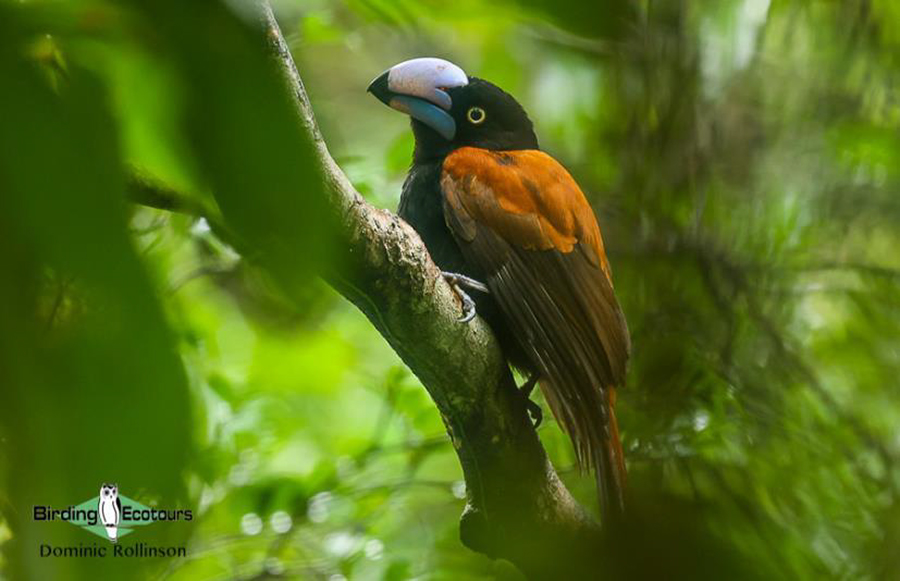
Helmet Vanga – always a strong candidate for ‘bird of the trip’!
We got back after noon and decided to take some time off after lunch to heal sore bodies and take a dip in the Indian Ocean. Our late afternoon walk was once again quiet, with the forest edge producing a similar suite of birds to the previous day’s afternoon walk. As we came back to our accommodation, we were alerted to the presence of a group of Eastern Lesser Bamboo Lemurs which were feeding in a small stand of bamboo.
Before dinner we did a night walk through the forest which was a little on the quiet side, but did produce a Rufous Mouse Lemur as well as an Eastern Woolly Lemur which was not at all perturbed by our presence. We slept well that night after a long day’s hike and knowing that we had Helmet Vanga ‘in the bag’!
Day 4, 29th September 2022. Full day birding the Masoala area
Today was our day to find our other major vanga target for the area, that being Bernier’s Vanga. We had heard it the previous day, but it had moved off with the flock before we could locate it. To find our quarry, we headed to the nearby Tampolo Marine Park where we explored a very different type of forest – the littoral forest, which has a much lower canopy and is dominated by Pandanus palms. Unlike the thick rainforest of the last couple days, this habitat type is a lot more open which makes viewing birds an easier task.
As we entered the littoral forest from the beach, we quickly bumped into Chabert Vanga and our first Common Jery of the trip. We then took a much easier walk through the forest until we emerged into a clearing to try for our target vanga and many others. Bernier’s Vanga showed up in no time and we all had prolonged views of the dark male and rufous-barred female, with bills which reminded us of oropendolas of the New World. We then birded the clearing for the next hour or so and worked through a couple of feeding flocks which contained the likes of Blue, Red-tailed and White-headed Vangas, Stripe-throated Jery, Common Newtonia, Madagascar Cuckooshrike, Long-billed Bernieria and Nelicourvi Weaver. Other birds seen in the area included Helmeted Guineafowl (an introduced species to Madagascar), Malagasy Coucal and Madagascar Starling. On our walk back through the forest we heard the crying call of Cuckoo-roller which would remain unseen, for now.

This female Bernier’s Vanga showed incredibly well for us at Masoala.
Before jumping back into our boats, we walked down to a beautiful, secluded beach where we enjoyed the view and got our first brief views of Malagasy Green Sunbird, before we had to tear ourselves away to enjoy a Madagascar Pratincole which posed nicely on a rock for us.

The Madagascar Pratincole seen at Masoala proved to be our only sighting of this species of the entire trip.
As we had cleaned-up on all our bird targets, we decided to take the afternoon off and enjoy the tranquility and beauty of the area. We enjoyed a swim and a gentle stroll along the beach which had a few Greater Crested and Roseate Terns on the nearby rocks. We capped off the day with a drink on the beach as we enjoyed another pretty Masoala sunset.
Day 5, 30th September 2022. Masoala Peninsula to Maroantsetra
This morning we had an early boat crossing back to Maroantsetra which was easier going, with the following swell and lack of rain showers. We had arranged to give ourselves at least a day between our boat crossing and our flight back to Tana, as the crossing can be unpredictable due to the weather. With our crossing going according to plan, we mostly took it easy for the day, however we did enjoy a late afternoon walk to the nearby river mouth which added Purple and Striated Herons, White-fronted Plover and gave us closer looks at a Malagasy Coucal. Later that afternoon, we were shown a pair of Tomato Frogs on the lawn of the lodge, however we all agreed that the animals did not feel truly wild to us and were probably just brought outside for us to see. After our dinner that evening, we wanted to try to find another Lowland Streaked Tenrec (as Mitch had missed them before) and before we had even left the steps to the restaurant one of these cute mammals ran by and gave us great views as it went about foraging.
Day 6, 01st October 2022. Maroantsetra to Antananarivo and Lake Alorobia birding
Our flight back to Tana was delayed by a couple of hours (nothing unusual for air travel in Madagascar) and so we only had to leave for the airport around mid-morning. We thus decided to take another walk back to the river mouth, which added a couple of distant Lesser Crested Terns and a few Common Sandpipers.
We enjoyed a scenic chartered flight back to Tana which gave us a better picture of the landscape and made us realize the scale of deforestation in the country. Once back in Tana, we spent a couple of hours at Lake Alorobia which is one of the last remaining refuges for waterbirds in and around the capital city. As soon as we walked through the gates, we were confronted by a huge assortment of birds which included masses of Red-billed Teals and White-faced Whistling Ducks and in amongst these common species we picked out Blue-billed Teal, Meller’s Duck and a single Fulvous Whistling Duck. The heronry was a hive of activity and included many Western Cattle, Dimorphic and Great Egrets, Squacco, Black-crowned Night and Black Herons and two Humblot’s Herons, with just one Malagasy Pond Heron seen, which was in full breeding plumage. We were also kept entertained by Malagasy Kingfisher, Malagasy Brush Warbler and Common Moorhen.
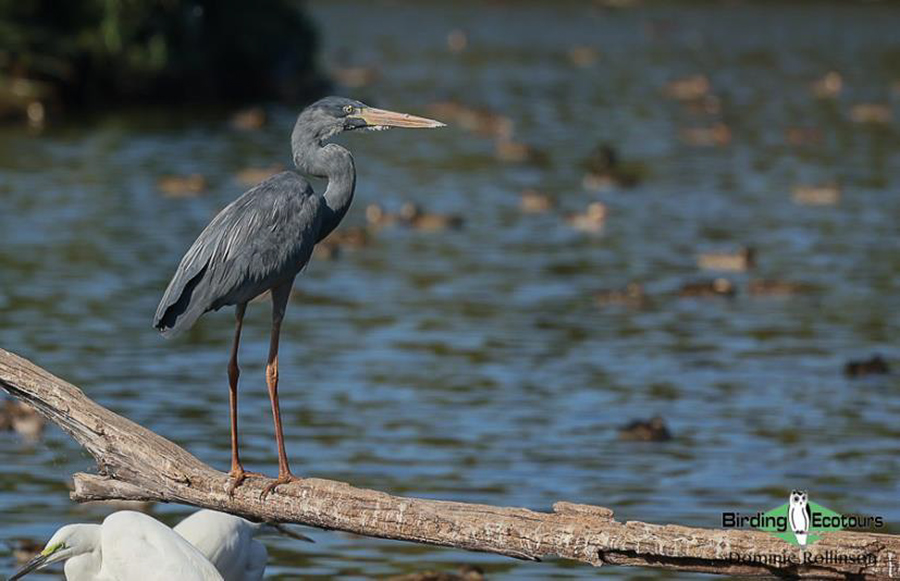
The uncommon Humblot’s Heron was seen well at Lake Alorobia.
Once back at our Tana hotel, we made sure to wait outside for Madagascar Nightjar which showed up right on cue (actually, two minutes late) and called from the neighbor’s chimney for most of the night.
Day 7, 02nd October 2022. Antananarivo to Andasibe
We made an early exit out of Tana this Sunday morning and hit the long, windy and bumpy road east to Andasibe. The drive was mostly uneventful, except for a roadside stop for Hamerkop which showed well for us. We arrived around midday at our lodge outside of Andasibe and immediately had lunch. We then headed out for our afternoon walk in Voimana Forest, a community-run conservation area just outside of Analamazaotra Mantadia National Park. We then met up with Patrice and Michael, two top-quality bird guides, who would be showing us the area for the next couple of days.
We had a fantastic afternoon on our forest walk, filled with great birds and other weird and wonderful Madagascan wildlife. The walk started with a pair of Madagascar Wood Rails which were extremely secretive and only a couple of us managed brief glimpses of them. Eventually we had to accept that the rails were not going to show much more for us and so we moved on to the next secretive rallid species, this time Madagascar Flufftail. Although not everyone got views of it, a male flufftail dashed across a clearing for us. We then moved further along the path and in the space of about 30 minutes we saw Madagascar Pygmy Kingfisher, Madagascar Cuckoo, Nuthatch Vanga (a catch-up for most), Ward’s Flycatcher, Velvet Asity, the huge Parson’s andsmaller Nose-horned Chameleons, Peacock Day Gecko, the bizarre Giraffe-necked Weevil, Eastern Woolly Lemur and a small group of Indri. Indri are Madagascar’s largest lemur and look rather strange with their stubbed tail. They are, however, incredibly agile and we watched them leap effortlessly between trees. We were even treated to their impressive vocalizations, which were incredibly loud. It was an amazing experience to listen to their mournful cries as they rang out through the forest.
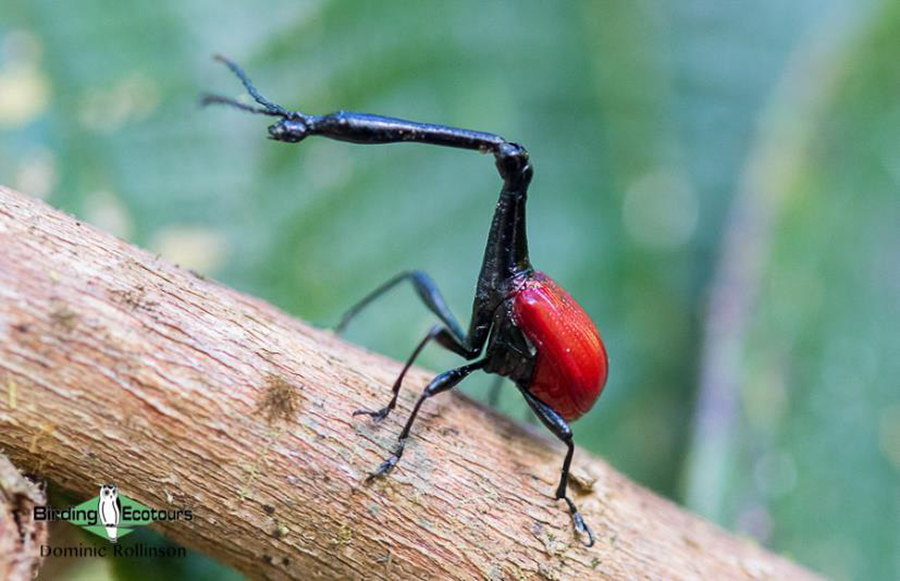
The crazy-looking Giraffe-necked Weevil was seen in the rainforests near Andasibe.
The rest of the walk was also exciting and the new birds continued arriving in the form of Green Jery, Rand’s Warbler and Malagasy Turtle Dove. Just before the end of the walk we had good looks at a friendly group of Common Brown Lemurs. We were shown the exceptionally well-camouflaged Mossy Leaf-tailed Gecko,which took us a while to make out – just the most unbelievable adaptation (see photo below)!
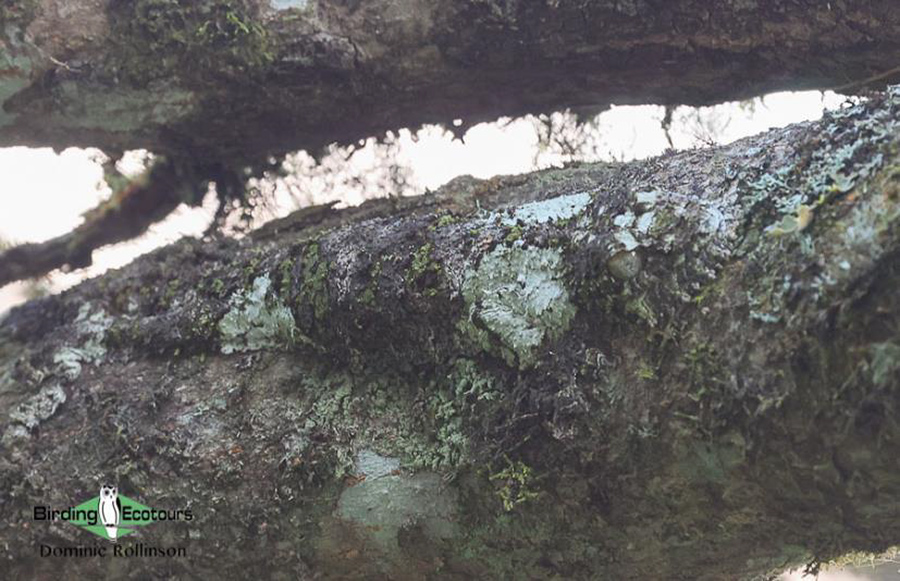
Can you see it? The cryptically camouflaged Mossy Leaf-tailed Gecko!
Day 8, 03rd October 2022. Birding Analamazaotra Mantadia National Park and surrounds
After another early breakfast, we were on our way out before sunrise, as we wanted an early start on the trails of Analamazaotra Mantadia National Park. First on the agenda was Madagascar Owl, which was seen high up at its day roost, with a Hook-billed Vanga also obliging nearby. Next was to get everyone onto Madagascar Flufftail, which proved much easier this morning and we all managed good looks at this elusive forest skulker. As we entered the forest we found a male Crossley’s Vanga which showed amazingly well for us as it sat nearby and sang for us (see front cover photo). Yet another example of the impressive adaptive radiation found within the vangas of Madagascar, this species is reminiscent of Rail-babbler of southeast Asia.
Deeper into the forest we found other good birds such as Red-fronted and Blue Couas, Madagascar Pygmy Kingfisher and Velvet Asity while feeding flocks had Blue, Tylas and Red-tailed Vangas as well as Madagascar Cuckooshrike. We had a number of good looks at the attractive Diademed Sifaka and even watched a few play around on the ground just a couple of yards from us. All the while, the cries of Indri resounded throughout the forest and we once again had good looks at these large lemurs. In an open area on the edge of the forest, we found our first Madagascar Cisticolas of the trip. Just before we headed back for lunch, Patrice showed us a Madagascar Tree Boa which was catching some sun on the edge of the road.
After a late lunch and some downtime, we headed to a nearby marshy area where we saw Madagascar Swamp Warbler and our big target, Madagascar Rail which showed on and off for a few minutes.
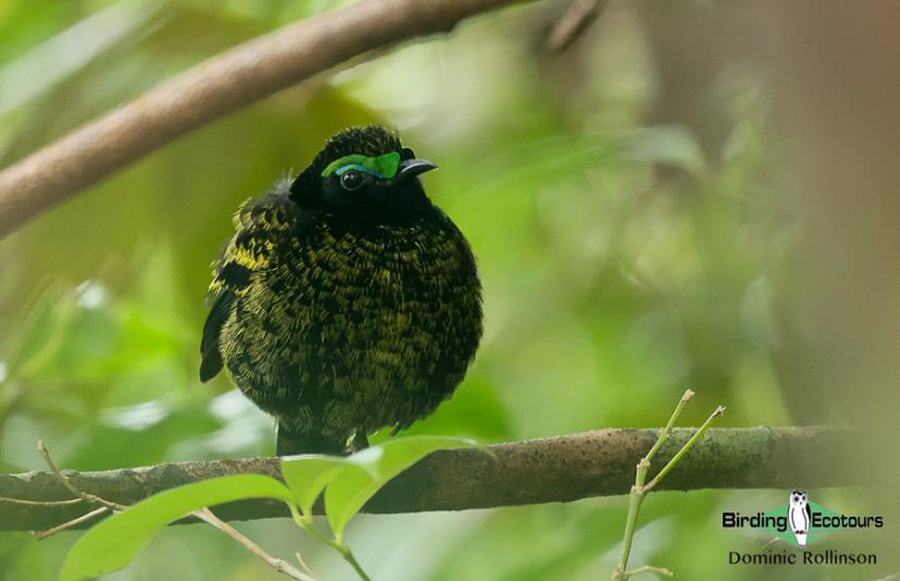
Velvet Asity (such as this non-breeding male) posed beautifully for us at several rainforest sites across Madagascar.
In the early evening we went for a night walk at the edge of Analamazaotra Mantadia National Park. We found Geoffroy’s Dwarf Lemur and the incredibly cute Goodman’s Mouse Lemur, but we could not see the calling Madagascar Owl or Madagascar Ibis. Green Bright-eyed Frog was also seen on our night walk.
Day 9, 04th October 2022. Maromizaha Forest birding
With a number of rainforest species still on our target list, we set out early for the nearby Maromizaha Forest, where we met the local guide Etienne who would show us around the forest for the morning. The morning walk extended into the early afternoon and proved to be a tough walk with lots of ups and downs, however we found many of our targets and had an enjoyable time out.
The forest was alive with bird song and activity and it did not take long to find a couple of Dark Newtonias, which gave us brief views. A pair of Malagasy Green Sunbirds were much more obliging and showed well for us. Next up was our bird of the day, in the form of Rufous-headed Ground Roller.This took some effort to see but we all eventually managed looks at this attractive species. At a view point over the forest we had distant views of the strange Cuckoo-roller, as well as a distant Madagascar Harrier-Hawk, which showed much better for us later in the morning. A feeding flock contained another target, Pollen’s Vanga, as well as Blue, Tylas and Nuthatch Vangas, Long-billed Bernieria and Madagascar Cuckooshrike.
We eventually made our way out of the forest (adding Madagascar Cuckoo and Madagascar Cisticola) and back to the vehicles and headed to our lodge for a late and well-deserved lunch. We mostly took it easy for the afternoon, although a gentle stroll around the lodge grounds produced Malagasy Paradise Flycatcher, Madagascar Wagtail and a large group of feeding Mascarene Martins.
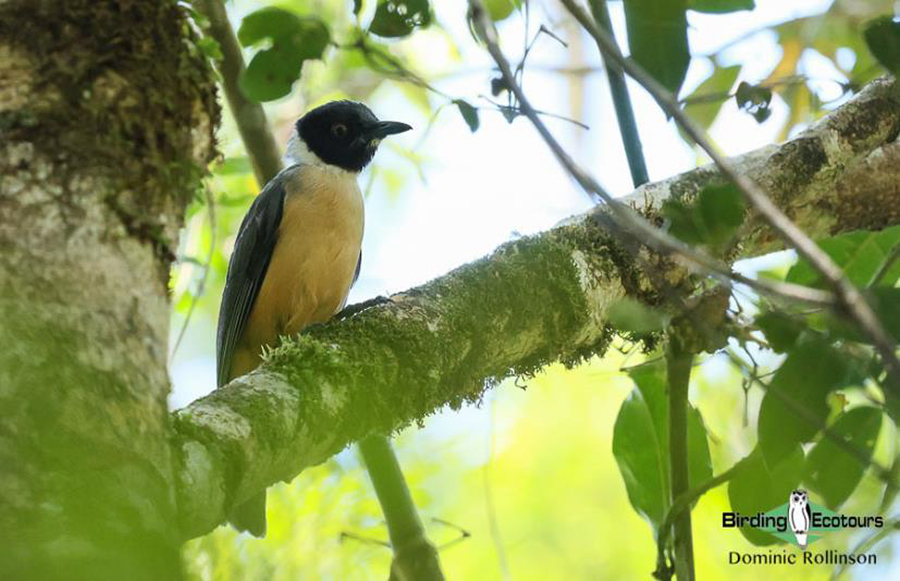
Tylas Vanga was commonly seen in feeding flocks in rainforests across Madagascar.
Day 10, 05th October 2022. Andasibe to Antsirabe
The next couple of days were mostly travel days as we made our way from the east of the country to the southeast. We left our lodge after an early breakfast and hit the long, slow road back to Tana and after pizzas for lunch we carried on southwards. The drive to Tana did not produce much of interest except a couple of Hamerkops, while we had no luck at a couple of stops for Madagascar Snipe. We eventually arrived in Madagascar’s second-largest city, Antsirabe, in the late afternoon and enjoyed another great meal.
Day 11, 06th October 2022. Antsirabe to Ranomafana
Today was another travel day as we made our way from Antsirabe southwards to Ranomafana where we had the exciting prospect of two full days of rainforest birding to try to clean up on as many of our missing targets as possible. The drive mostly contained the usual suspects such as Pied Crow, Yellow-billed (Black) Kite, Malagasy Kestrel and Great, Dimorphic and Western Cattle Egrets, however we did find a new trip bird, a single Peregrine Falcon.
We arrived in Ranomafana village in the early afternoon and took it easy for the rest of the afternoon before an early evening night walk with Stephan (who would be showing us around for the next couple of days). We had better views of Rufous Mouse Lemur and found two new chameleon species; Short-nosed and Deceptive Chameleons.
Day 12, 07th October 2022. Ranomafana National Park birding
This morning we had a few rainforest species to target and set out just after sunrise to walk the trails around Vohiparara. The hike was again strenuous, but far easier than Maromizaha and we ended up having a great morning and found many of our targets. As we got out of the bus, Stephan immediately heard Forest Rock Thrush calling and it did not take long for us to get good views of a male. We then hit the trail proper and soon heard the deep call of a Pitta-like Ground Roller. Stephan and his two sons (Stephan Jr and James) worked hard and after a while we all had excellent looks at a calling bird which did not seem perturbed by our presence. Our fourth and final rainforest ground roller!
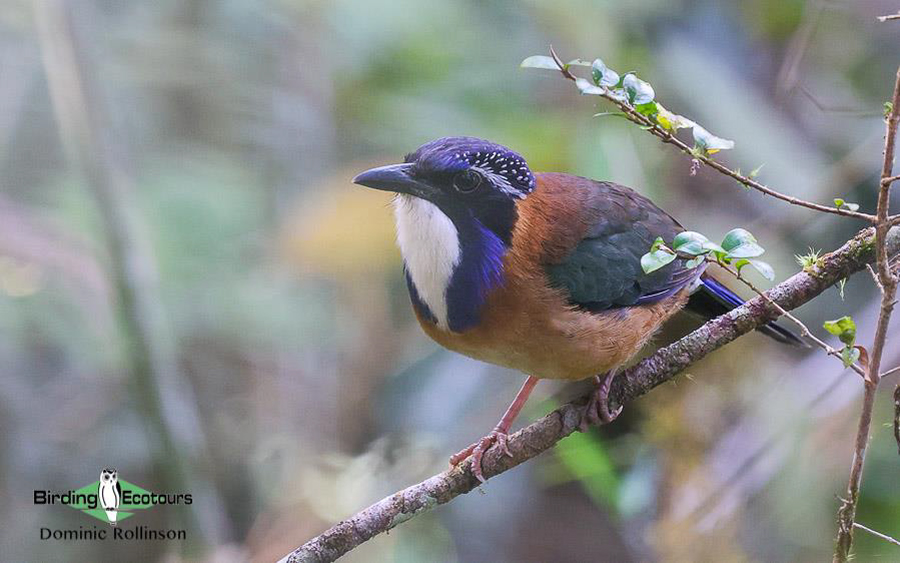
Our final rainforest ground roller, the gorgeous Pitta-like Ground Roller.
The great birding continued as we went further along the trail where we had to work hard for Cryptic Warbler but we all eventually got good looks at this recently (in the 1990s) discovered species. The tiny Common Sunbird-Asity showed well for us, however the rarer Yellow-bellied Sunbird-Asity could not be found. We then bumped into a small bird party which had both Wedge-tailed Jery (Tetraka) and Grey-crowned Tetraka feeding right alongside each other, providing nice comparative views. We had to work harder still for the cute and colorful Madagascan Yellowbrow (Yellow-browed Oxylabes) but eventually had them just a couple of yards away from us. Brown Emutail is one of Madagascar’s super-skulkers and today was no different, as we had brief views as it ran along the ground, reminiscent of a small mouse. Some of us managed looks at a calling Rufous-headed Ground Roller however this individual was not as obliging as before. Other good birds seen on the walk included Velvet Asity, Lesser Vasa Parrot, Cuckoo-roller, Tylas Vanga (on a nest) and a circling Madagascar Cuckoo-Hawk, as we got back to the bus. Despite us not targeting lemurs, we managed to find three species this morning including Milne-Edward’s Sifaka, Red-bellied Lemur and Eastern Lesser Bamboo Lemur – another great morning in the rainforests of Madagascar!
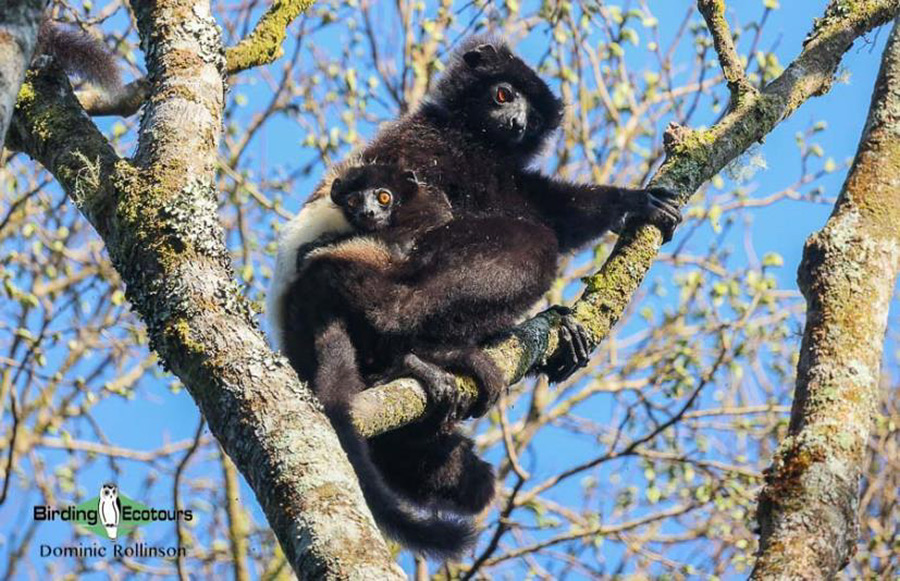
Yet another lemur species – Milne-Edward’s Sifaka.
After lunch and some time off, we headed into some nearby rice paddies to look for Madagascar Snipe, which could not be found. However, once we got back into the rainforest, we had our best looks at Ward’s Vanga and had a small group of Malagasy Black Swifts overhead.
Day 13, 08th October 2022. Ranomafana National Park birding
We were exploring a different section of Ranomafana today and once again headed out of the door before sunrise and hit the trails for a few more of our rainforest targets. Today was our last day of rainforest birding and so we wanted to find as many of our targets as possible. It didn’t take too long before Stephan had heard the distant excited squeal of Madagascar Wood Rail and after much anguish and effort, we all had satisfactory views of this tricky skulker. We had a couple of good feeding flocks which revealed further good birds including Long-billed Bernieria (Tetraka), White-headed, Blue, Chabert and Tylas Vangas and the hoped-for Rufous Vanga. Pitta-like Ground Roller was seen briefly, while we saw flashes of Lesser Vasa Parrots as they flew noisily above the forest canopy. Despite the best efforts of the local guides, who checked all the regular roosts sites, we could not locate any roosting Collared Nightjars and had to accept defeat with this rare forest beauty. Just before finishing our forest walk, we added Forest Fody and a showy male Nelicourvi Weaver.
After our forest walk, we headed out to a nearby marsh. The lengthy walk to reach it was worth the effort as we had lovely views of singing Grey Emutails sitting out in the open for us all to enjoy.
For the afternoon, Mitch and Ron decided to enjoy a local football game just down the road (which ended 1-0 to the local team!) while Chris, Teri, Dom and Stephan headed back into the deep forest, to see what might be on offer. As is often the case with afternoon birding in Madagascar, it was quiet although we did get looks at Ward’s Flycatcher and a new lemur species, Red-fronted Brown Lemur.
Day 14, 09th October 2022. Ranomafana National Park to Isalo
Today was mostly a driving day as we made our way from the rainforests of Ranomafana to the impressive sandstone formations near Isalo National Park, with a couple of birding and wildlife stops en route. Our first stop was at Anja Community Reserve where it did not take long to find a group of Ring-tailed Lemurs which were relaxing in the late-morning heat. We enjoyed these distinctive-looking lemurs for a while before taking a short walk around the vegetated areas which yielded brief views of Madagascar Buttonquail and a couple of pretty Grey-headed Lovebirds.
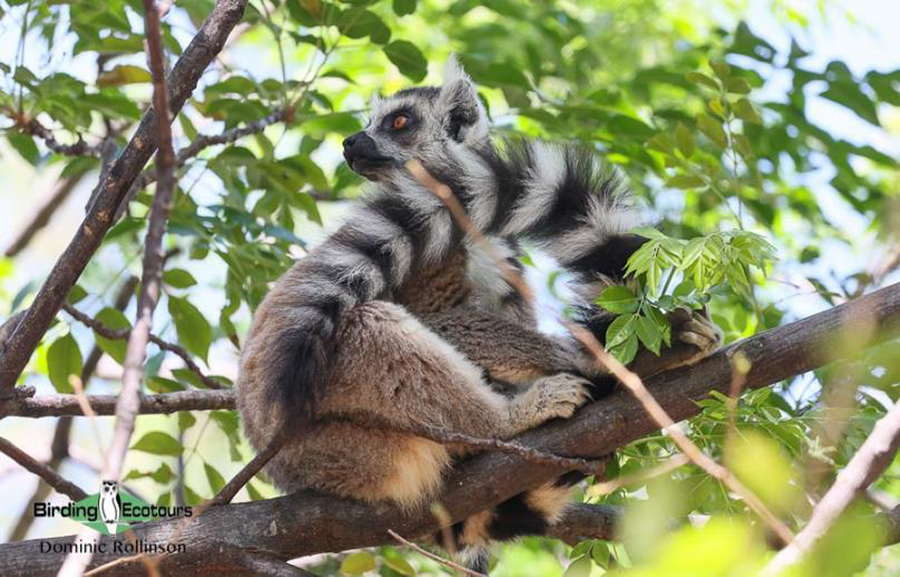
The distinctive Ring-tailed Lemur, seen at Anja Community Reserve.
Just before checking into our lovely accommodation near Isalo, we stopped at a known site for the Benson’s subspecies of Forest Rock Thrush which did not take long to show up. A quick wander around the lodge grounds added good looks at Madagascar Hoopoe. Our afternoon birding session for Madagascar Partridge did not prove successful, although we did see our only Alpine Swifts of the trip. Our evening owling session was highly successful as we enjoyed fantastic views of the brown and grey morph of Torotoroka Scops Owl while Chris and Teri heard the screech of a Western Barn Owl and Dom had a White-browed Owl later that evening.
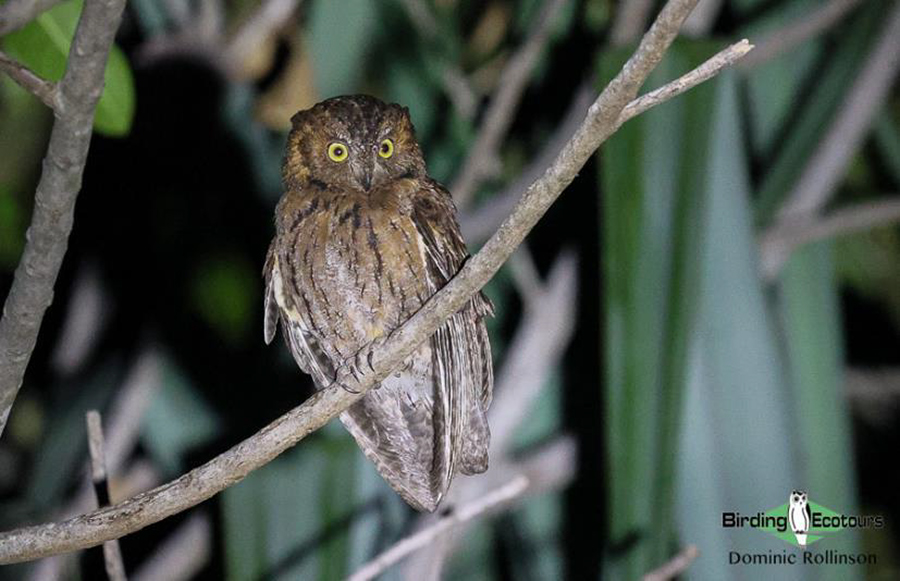
This brown-morph Torotoroka Scops Owl showed well for us near Isalo National Park.
Day 15, 10th October 2022. Zombitse birding and transfer to Ifaty
Yet another pre-dawn start as we were soon on our way towards the dry deciduous forests of Zombitse-Vohibasia National Park. We gave our target list to the local guides who soon started working through these drier-country specials. Before we had even entered the forest, we found a couple of Madagascar Green Pigeons which were catching the first of the sun’s rays. Next up was Giant Coua which posed nicely at the top of a tree, with a few Crested Couas being seen throughout the morning while Coquerel’s Coua took a lot more work, but eventually showed for all of us. After a while our primary target, the localized Appert’s Tetraka, showed incredibly well for us and was seemingly not perturbed by our presence. We were then shown two roosting owls, another White-browed Owl and then a cute Torotoroka Scops Owl which was hiding in a hole in a tree. In the dry deciduous forest, we also had our best views of Cuckoo-roller as they flew noisily overhead. We were shown a nesting Hook-billed Vanga which again vastly improved our views of this shrike-like vanga. During our time in Zombitse we also saw two species of lemur, Verreaux’s Sifaka and Hubbard’s (Zombitse) Sportive Lemur.
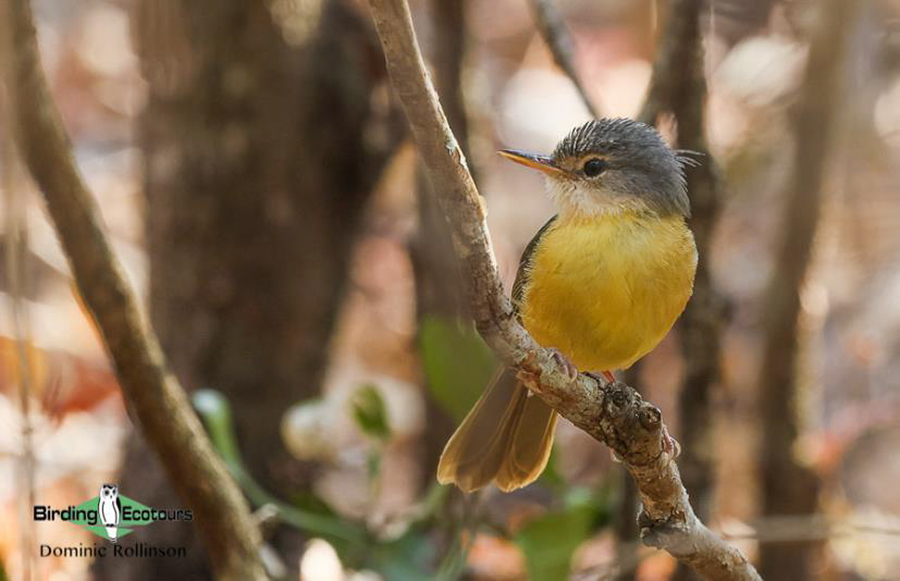
The cute Appert’s Tetraka at Zombitse.
After a highly successful morning in the dry deciduous forest, we once again hit the open road, with one last birding stop before making it to the coast at Ifaty. We were targeting Madagascar Sandgrouse this morning and pulled up at a known site where we were greeted by around 20 enthusiastic sandgrouse spotters. Soon other villagers had joined our party and we headed off into the farming areas where the sandgrouse feed. It was rather chaotic as local kids sprinted off in every direction in the hopes of finding the sandgrouse. After a little while the excitement levels increased and it emerged that a small group of sandgrouse had been spotted nearby. The scouts were maybe a little too loud and enthusiastic and before we knew it the sandgrouse had taken flight and we all got some unsatisfying flight views. However, eagle-eyed Teri soon spotted a closer group sitting under some bushes and we all enjoyed prolonged scope views of this tough endemic. We all enjoyed the experience but were also happy to return to the relative serenity of the bus.
The rest of the drive went by uneventfully, and we arrived at our lovely beachside lodge in the mid-afternoon and decided to relax by the pool for the rest of the afternoon. Even while relaxing, binoculars were always close at hand, as we added Subdesert Brush Warbler to our ever-growing list!
Day 16, 11th October 2022. Birding in the spiny forest
We were in the bus at 04h45 this morning because we wanted to spend the morning birding the incredible spiny forest before it heated up too much. Seeing the baobab and octopus trees in the pre-dawn light was something none of us would forget in a hurry and the birding was equally impressive. We spent the morning with local guides, Ray, Ellius and Christian as they worked the area for spiny forest specials. It did not take too long until we found our fifth and final ground roller, Long-tailed Ground Roller, with a pair providing splendid looks for all of us. We saw three species of couas this morning, Running, Crested and Red-capped Couas, which are always fun to see. We then heard the high-pitched excited calls of a raptor and saw a large and powerful female Madagascar Sparrowhawk constructing a nest nearby. Other targets which we saw this morning included Thamnornis, Archbold’s Newtonia and the bizarre Sickle-billed Vanga. Unfortunately, Subdesert Mesite could not be found this morning and would have to wait for the afternoon birding session.
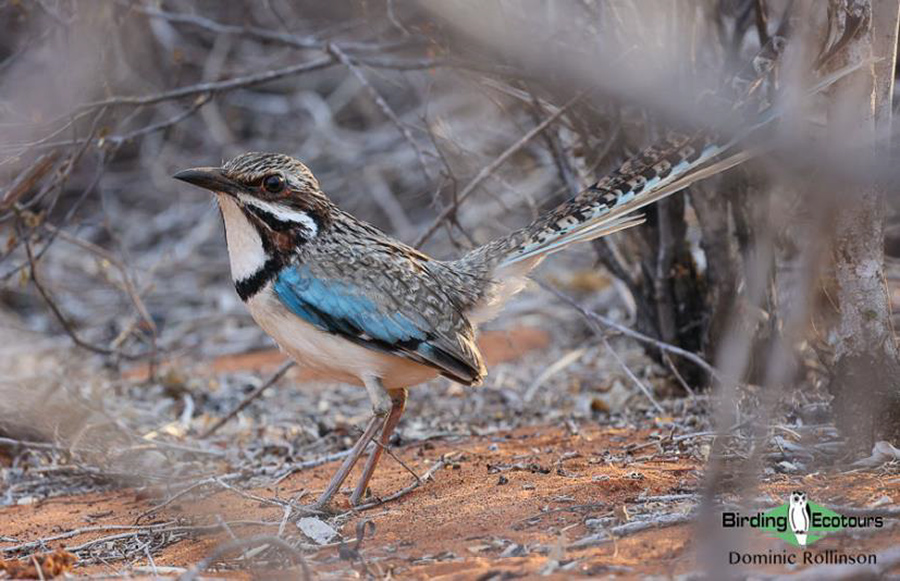
Long-tailed Ground Roller at Ifaty made it five out of five ground rollers for our tour.
After a tasty breakfast overlooking the ocean, we headed out to some nearby salt pans where we found a single Madagascar Plover as well as Ruddy Turnstone, Grey and Kittlitz’s Plovers and Common Sandpiper. The nearby wetlands were a little disappointing and it was sad to see how much of the reedbeds had been harvested in the area. We did however add a few new shorebirds around the wetland and on the drive, including Curlew Sandpiper, Common Ringed Plover, Little Stint, Common Whimbrel and Common Greenshank.
Day 17, 12th October 2022. Birding La Table and coastal birding
Yet another early start and we were once again on our way before sunrise, this time with four targets in mind for our birding around La Table. It did not take long after arriving at La Table before we heard the call of Red-shouldered Vanga, a species which was only discovered as recently as 1997 and was the final list addition of the famous world-lister, Phoebe Snetsinger, before her tragic death in 1999! We hurried through the thick scrub and it did not take long until we had great views of this highly localized endemic. Soon after the vanga, we had brief views of Verreaux’s Coua and then almost immediately afterwards we had longer looks at Lafresnaye’s Vanga. As we were heading back to the vehicle, we got better looks at Verreaux’s Coua and improved our views of Red-capped Coua. Our final target for the morning was Madagascar Buttonquail which showed almost immediately as we got out of the vehicle at a nearby stakeout. After a highly successful morning out, we headed back to Ifaty where we enjoyed a relaxed late breakfast and packed our bags, as we were moving to Toliara for the evening.
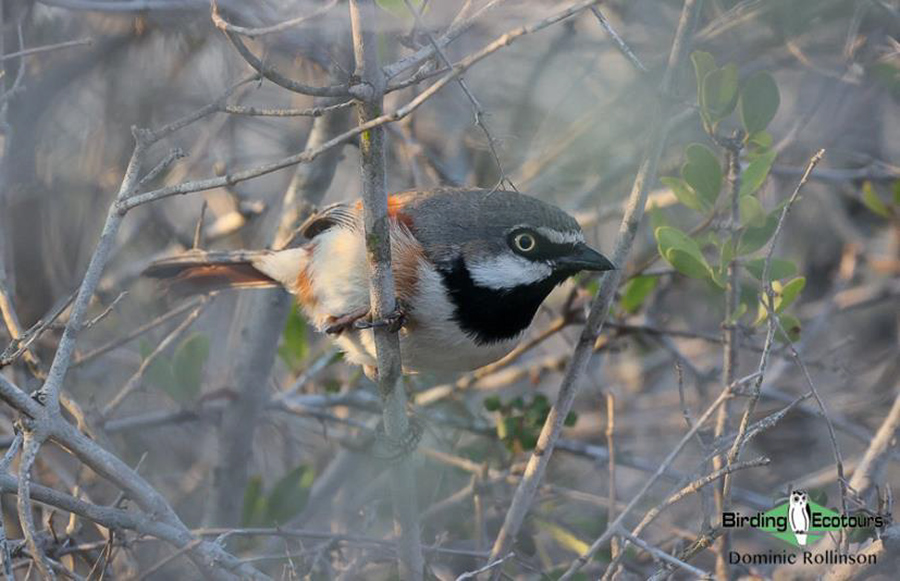
Red-shouldered Vanga did not prove too tricky around La Table.
We spent the late morning slowly making our way south to Toliara, and birded the salt pans and mud flats in the area where we saw Kittlitz’s, White-fronted and Grey Plovers, Curlew Sandpiper, Ruddy Turnstone, Eurasian Whimbrel, Common Sandpiper and Common Greenshank. We arrived at our new hotel in the busy town of Toliara around lunchtime and after an enjoyable meal we decided to take some time off before some late-afternoon birding.
With just about all our targets in the bag now, we headed out to bird some mudflats outside of Toliara. They were a little on the quiet side, although we did add Three-banded Plover (the endemic Madagascar subspecies) and also had good views of Common Ringed Plover and a few flyover Grey-headed Lovebirds.
Day 18, 13th October 2022. Toliara birding and flight to Tana
This was our last morning of birding in the southwest and so we headed out to the nearby Antsokay Arboretum to see what else we could find. Almost immediately we improved our views of Madagascar Buttonquail. We then enjoyed being shown some of the area’s interesting reptiles and learning about the local flora from our knowledgeable local guide. Mitch was pleased as we found a pair of confiding Grey-headed Lovebirds – a nice catchup bird (or ketchup bird)! Some of the more interesting reptile ticks this morning included Madagascar Iguana, Madagascar Dwarf Gecko, Thicktail Day Gecko and Madagascar Keeled Cordylid. Just before we ended the morning we had fantastic views of a friendly Red-capped Coua!
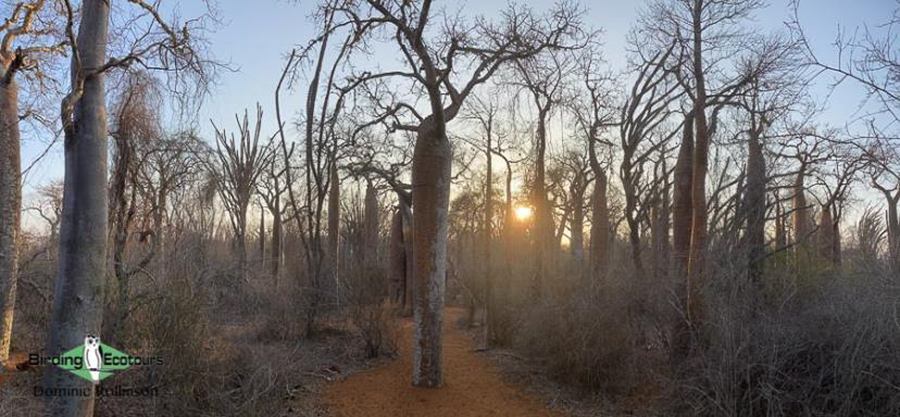
The spiny forests of southwestern Madagascar are truly beautiful at sunrise.
The rest of the morning was spent enjoying breakfast and packing bags before our early afternoon flight back to Tana (unsuccessfully scanning the airport light poles for Sooty Falcon – too early in the season it seems) where we relaxed before our final dinner of the trip.
Day 19, 14th October 2022. Lake Alorobia birding and departure
As most of us had afternoon flights out of Tana, we decided to enjoy our last morning in Madagascar by heading back to Lake Alorobia, about the only accessible birding spot around the capital city. We once again had good looks at the many heron and egret species on offer including Humblot’s, Striated, Sqaucco, Black, Malagasy Pond and Black-crowned Night Herons and Great and Dimorphic Egrets. Meller’s Ducks showed well again and we had a good scan for Knob-billed Duck which had been seen a week ago but decided the bird had likely moved on. We managed our best looks of the trip at White-throated Rail before we headed back to the hotel to pack our bags and enjoy our final lunch before heading to the airport where we all went our separate ways. Teri and Dom were lucky to spot a couple of pairs of Madagascar Partridge as the plane taxied out onto the runway – always worth keeping binoculars near at hand at Tana airport!
A big thank you to Fan who expertly handled all the logistics and kept us healthy by letting us know what we could and could not eat and to Chris who diligently and accurately eBirded every day and happily shared these lists with all of us. The efforts of the site guides were highly appreciated, without whom we would have seriously battled to get any views of the many specials they showed us. Madagascar is not for the faint-hearted, but for those who are willing to venture out of their comfort zone, they are sure to be rewarded with many amazing bird endemics and an assortment of other weird and whacky wildlife!
Bird List – Following IOC (12.1)
Birds ‘heard only’ are marked with (H) after the common name, all other species were seen.
The following notation after species names is used to show conservation status following BirdLife International. CR = Critically Endangered, EN = Endangered, VU = Vulnerable
Madagascar endemics are in bold.
| Common Name | Scientific Name |
| Ducks, Geese, Swans | |
| White-faced Whistling Duck | Dendrocygna viduata |
| Fulvous Whistling Duck | Dendrocygna bicolor |
| Blue-billed Teal | Spatula hottentota |
| Meller’s Duck – EN | Anas melleri |
| Red-billed Teal | Anas erythrorhyncha |
| Guineafowl (Numididae) | |
| Helmeted Guineafowl | Numida meleagris |
| Pheasants & Allies (Phasianidae) | |
| Madagascar Partridge | Margaroperdix madagarensis |
| Nightjars (Caprimulgidae) | |
| Madagascar Nightjar | Caprimulgus madagascariensis |
| Swifts (Apodidae) | |
| Madagascar Spinetail | Zoonavena grandidieri |
| Malagasy Palm Swift | Cypsiurus gracilis |
| Alpine Swift | Tachymarptis melba |
| Malagasy Black Swift | Apus balstoni |
| Cuckoos (Cuculidae) | |
| Malagasy Coucal | Centropus toulou |
| Crested Coua | Coua cristata |
| Verreaux’s Coua | Coua verreauxi |
| Blue Coua | Coua caerulea |
| Red-capped Coua | Coua ruficeps |
| Red-fronted Coua | Coua reynaudii |
| Coquerel’s Coua | Coua coquereli |
| Running Coua | Coua cursor |
| Giant Coua | Coua gigas |
| Red-breasted Coua | Coua serriana |
| Madagascar Cuckoo | Cuculus rochii |
| Mesites (Mesitornithidae) | |
| Brown Mesite – VU | Mesitornis unicolor |
| Subdesert Mesite – VU | Monias benschi |
| Sandgrouse (Pteroclidae) | |
| Madagascar Sandgrouse | Pterocles personatus |
| Pigeons, Doves (Columbidae) | |
| Rock Dove | Columba livia |
| Malagasy Turtle Dove | Nesoenas picturatus |
| Namaqua Dove | Oena capensis |
| Madagascar Green Pigeon | Treron australis |
| Madagascar Blue Pigeon | Alectroenas madagascariensis |
| Flufftails (Sarothruridae) | |
| Madagascar Wood Rail | Mentocrex kioloides |
| Madagascar Flufftail | Sarothrura insularis |
| Rails, Crakes & Coots (Rallidae) | |
| Madagascar Rail – VU | Rallus madagascariensis |
| White-throated Rail | Dryolimnas cuvieri |
| Common Moorhen | Gallinula chloropus |
| Buttonquail (Turnicidae) | |
| Madagascar Buttonquail | Turnix nigricollis |
| Stilts, Avocets (Recurvirostridae) | |
| Black-winged Stilt | Himantopus himantopus |
| Plovers (Charadriidae) | |
| Grey Plover | Pluvialis squatarola |
| Common Ringed Plover | Charadrius hiaticula |
| Madagascar Plover – VU | Charadrius thoracicus |
| Kittlitz’s Plover | Charadrius pecuarius |
| Three-banded Plover | Charadrius tricollaris |
| White-fronted Plover | Charadrius marginatus |
| Sandpipers, Snipes (Scolopacidae) | |
| Eurasian Whimbrel | Numenius phaeopus |
| Ruddy Turnstone | Arenaria interpres |
| Curlew Sandpiper | Calidris ferruginea |
| Little Stint | Calidris minuta |
| Common Sandpiper | Actitis hypoleucos |
| Common Greenshank | Tringa nebularia |
| Coursers, Pratincoles (Glareolidae) | |
| Madagascar Pratincole – VU | Glareola ocularis |
| Gulls, Terns, Skimmers (Laridae) | |
| Greater Crested Tern | Thalasseus bergii |
| Lesser Crested Tern | Thalasseus bengalensis |
| Roseate Tern | Sterna dougallii |
| Cormorants, Shags (Phalacrocoracidae) | |
| Reed Cormorant | Microcarbo africanus |
| Ibises, Spoonbills (Threskiornithidae) | |
| Madagascar Ibis (H) | Lophotibis cristata |
| Herons, Bitterns (Ardeidae) | |
| Black-crowned Night Heron | Nycticorax nycticorax |
| Striated Heron | Butorides striata |
| Squacco Heron | Ardeola ralloides |
| Malagasy Pond Heron – EN | Ardeola idae |
| Western Cattle Egret | Bubulcus ibis |
| Humblot’s Heron – EN | Ardea humbloti |
| Purple Heron | Ardea purpurea |
| Great Egret | Ardea alba |
| Black Heron | Egretta ardesiaca |
| Dimorphic Egret | Egretta dimorpha |
| Hamerkop (Scopidae) | |
| Hamerkop | Scopus umbretta |
| Kites, Hawks, Eagles (Accipitridae) | |
| Madagascar Harrier-Hawk | Polyboroides radiatus |
| Madagascar Cuckoo-Hawk | Aviceda madagascariensis |
| Frances’s Sparrowhawk | Accipiter francesiae |
| Madagascar Sparrowhawk | Accipiter madagascariensis |
| Henst’s Goshawk – VU | Accipiter henstii |
| Yellow-billed Kite | Milvus aegyptius |
| Madagascar Buzzard | Buteo brachypterus |
| Owls (Strigidae) | |
| White-browed Owl | Athene superciliaris |
| Torotoroka Scops Owl | Otus madagascariensis |
| Rainforest Scops Owl | Otus rutilus |
| Madagascar Owl | Asio madagascariensis |
| Cuckoo-roller (Leptosomidae) | |
| Cuckoo-roller | Leptosomus discolor |
| Hoopoes (Upupidae) | |
| Madagascar Hoopoe | Upupa marginata |
| Rollers (Coraciidae) | |
| Broad-billed Roller | Eurystomus glaucurus |
| Ground Rollers (Brachypteraciidae) | |
| Short-legged Ground Roller – VU | Brachypteracias leptosomus |
| Scaly Ground Roller – VU | Geobiastes squamiger |
| Pitta-like Ground Roller | Atelornis pittoides |
| Rufous-headed Ground Roller | Atelornis crossleyi |
| Long-tailed Ground Roller – VU | Uratelornis chimaera |
| Kingfishers (Alcedinidae) | |
| Madagascar Pygmy Kingfisher | Corythornis madagascariensis |
| Malagasy Kingfisher | Corythornis vintsioides |
| Bee-eaters (Meropidae) | |
| Olive Bee-eater | Merops superciliosus |
| Caracaras, Falcons (Falconidae) | |
| Malagasy Kestrel | Falco newtoni |
| Peregrine Falcon | Falco peregrinus |
| Old World Parrots (Psittaculidae) | |
| Greater Vasa Parrot | Coracopsis vasa |
| Lesser Vasa Parrot | Coracopsis nigra |
| Grey-headed Lovebird | Agapornis canus |
| Asities (Philepittidae) | |
| Velvet Asity | Philepitta castanea |
| Common Sunbird-Asity | Neodrepanis coruscans |
| Vangas & Allies (Vangidae) | |
| Red-tailed Vanga | Calicalicus madagascariensis |
| Red-shouldered Vanga – VU | Calicalicus rufocarpalis |
| Hook-billed Vanga | Vanga curvirostris |
| Bernier’s Vanga – EN | Oriolia bernieri |
| Lafresnaye’s Vanga | Xenopirostris xenopirostris |
| Pollen’s Vanga | Xenopirostris polleni |
| Sickle-billed Vanga | Falculea palliata |
| White-headed Vanga | Artamella viridis |
| Chabert Vanga | Leptopterus chabert |
| Blue Vanga – EN | Cyanolanius madagascarinus |
| Rufous Vanga | Schetba rufa |
| Helmet Vanga – EN | Euryceros prevostii |
| Tylas Vanga | Tylas eduardi |
| Nuthatch Vanga | Hypositta corallirostris |
| Dark Newtonia | Newtonia amphichroa |
| Common Newtonia | Newtonia brunneicauda |
| Archbold’s Newtonia | Newtonia archboldi |
| Ward’s Flycatcher | Pseudobias wardi |
| Crossley’s Vanga | Mystacornis crossleyi |
| Cuckooshrikes (Campephagidae) | |
| Madagascar Cuckooshrike | Ceblepyris cinereus |
| Drongos (Dicruridae) | |
| Crested Drongo | Dicrurus forficatus |
| Monarchs (Monarchidae) | |
| Malagasy Paradise Flycatcher | Terpsiphone mutata |
| Crows, Jays (Corvidae) | |
| Pied Crow | Corvus albus |
| Larks (Alaudidae) | |
| Madagascar Lark | Eremopterix hova |
| Bulbuls (Pycnonotidae) | |
| Malagasy Bulbul | Hypsipetes madagascariensis |
| Swallows, Martins (Hirundinidae) | |
| Mascarene Martin | Phedina borbonica |
| Brown-throated Martin | Riparia paludicola |
| Reed Warblers & Allies (Acrocephalidae) | |
| Malagasy Brush Warbler | Nesillas typica |
| Subdesert Brush Warbler | Nesillas lantzii |
| Madagascar Swamp Warbler | Acrocephalus newtoni |
| Grassbirds & Allies (Locustellidae) | |
| Grey Emutail | Bradypterus seebohmi |
| Brown Emutail | Bradypterus brunneus |
| Tetrakas & Allies (Bernieridae) | |
| White-throated Oxylabes | Oxylabes madagascariensis |
| Long-billed Bernieria | Bernieria madagascariensis |
| Cryptic Warbler | Cryptosylvicola randrianasoloi |
| Wedge-tailed Jery | Hartertula flavoviridis |
| Thamnornis | Thamnornis chloropetoides |
| Spectacled Tetraka | Xanthomixis zosterops |
| Appert’s Tetraka – VU | Xanthomixis apperti |
| Grey-crowned Tetraka | Xanthomixis cinereiceps |
| Madagascar Yellowbrow | Crossleyia xanthophrys |
| Rand’s Warbler | Randia pseudozosterops |
| Cisticolas & Allies (Cisticolidae) | |
| Common Jery | Neomixis tenella |
| Green Jery | Neomixis viridis |
| Stripe-throated Jery | Neomixis striatigula |
| Madagascar Cisticola | Cisticola cherina |
| White-eyes (Zosteropidae) | |
| Malagasy White-eye | Zosterops maderaspatanus |
| Starlings, Rhabdornis (Sturnidae) | |
| Common Myna | Acridotheres tristis |
| Madagascar Starling | Hartlaubius auratus |
| Chats, Old World Flycatchers (Muscicapidae) | |
| Madagascar Magpie-Robin | Copsychus albospecularis |
| Forest Rock Thrush | Monticola sharpei |
| Madagascar Stonechat | Saxicola sibilla |
| Sunbirds (Nectariniidae) | |
| Souimanga Sunbird | Cinnyris sovimanga |
| Malagasy Green Sunbird | Cinnyris notatus |
| Old World Sparrows, Snowfinches (Passeridae) | |
| House Sparrow | Passer domesticus |
| Weavers, Widowbirds (Ploceidae) | |
| Nelicourvi Weaver | Ploceus nelicourvi |
| Sakalava Weaver | Ploceus sakalava |
| Red Fody | Foudia madagascariensis |
| Forest Fody | Foudia omissa |
| Waxbills, Munias & Allies (Estrildidae) | |
| Madagascar Mannikin | Lepidopygia nana |
| Wagtails, Pipits (Motacillidae) | |
| Madagascar Wagtail | Motacilla flaviventris |
| Species Seen | 156 |
| Species heard only | 1 |
| Total species recorded | 157 |
Mammal List
Mammals ‘heard only’ are marked with (H) after the common name, all other species were seen.
The following notation after species names is used to show conservation status following the IUCN Red List: CR = Critically Endangered, EN = Endangered, VU = Vulnerable, NT = Near Threatened.
| Common name | Scientific name |
| Tenrecs (Tenrecidae) | |
| Lowland Streaked Tenrec | Hemicentetes semispinosus |
| Climbing mice, rock mice, Malagasy rats and mice (Neosmyidae) | |
| Eastern Red Forest Rat | Nesomys rufus |
| Dwarf and Mouse Lemurs (Cheirogaleidae) | |
| Geoffroy’s Dwarf Lemur – VU | Cheirogaleus major |
| Goodman’s Mouse Lemur – NT | Microcebus lehilahytsara |
| Rufous Mouse Lemur – VU | Microcebus rufus |
| True Lemurs (Lemuridae) | |
| Common Brown Lemur – VU | Eulemur fulvus |
| Red-fronted Brown Lemur – VU | Eulemur rufifrons |
| White-fronted Lemur – VU | Eulemur albifrons |
| Red-bellied Lemur – VU | Eulemur rubriventer |
| Eastern Lesser Bamboo Lemur – VU | Hapalemur griseus |
| Ring-tailed Lemur – EN | Lemur catta |
| Red Ruffed Lemur – CR | Varecia rubra |
| Black-and-white Ruffed Lemur – CR (H) | Varecia variegata |
| Sportive Lemurs (Lepilemuridae) | |
| Seal’s Sportive Lemur – VU | Lepilemur seali |
| Hubbard’s (Zombitse) Sportive Lemur – EN | Lepilemur hubbardorum |
| Indriids (Indriidae) | |
| Indri – CR | Indri indri |
| Eastern Woolly Lemur – VU | Avahi laniger |
| Diademed Sifaka – CR | Propithecus diadema |
| Milne-Edward’s Sifaka – EN | Propithecus edwardsi |
| Verreaux’s Sifaka – CR | Propithecus verreauxi |
| Species Seen | 19 |
| Species heard only | 1 |
| Total species recorded | 20 |
Reptile and Amphibian List
| Common Name | Scientific Name |
| Chameleons (Chamaeleonidae) | |
| Deceptive Chameleon | Calumma fallax |
| Short-nosed (Side-striped) Chameleon | Calumma gastrotaenia |
| Nose-horned Chameleon | Calumma nasutum |
| Parson’s Chameleon – NT | Calumma parsoni |
| Brown Leaf (Stub-tailed) Chameleon | Brookesia superciliaris |
| Oustalet’s Chameleon | Furcifer oustaleti |
| Geckos (Gekkonidae) | |
| Mossy Leaf-tailed Gecko | Uroplatus sikorae |
| Peacock Day Gecko | Phelsuma quadriocellata |
| Lined Day Gecko | Phelsuma lineata |
| Thicktail Day Gecko | Phelsuma mutabilis |
| Common House Gecko | Hemidactylus frenatus |
| Madagascar Dwarf Gecko – NT | Lygodactylus klemmeri |
| Plated Lizards (Gerrhosauridae) | |
| Ornate Plated Lizard | Zonosaurus ornatus |
| Madagascar Keeled Cordylid | Tracheloptychus madagascariensis |
| Madagascan Iguanas (Opluridae) | |
| Madagascar Iguana | Chalarodon madagascariensis |
| Merrem’s Madagascar Swift | Oplurus cyclurus |
| Madagascar Spotted Spiny-tailed Iguana | Oplurus quadrimaculatus |
| Boas (Boidae) | |
| Madagascar Tree Boa | Sanzinia madagascariensis |
| Elapoid Snakes (Psammophiidae) | |
| Common Big-eyed Snake | Mimophis mahfalensis |
| Grassland Frogs (Ptychadenidae) | |
| Mascarene Grass Frog | Ptychadena mascareniensis |
| Mantellids (Mantellidae) | |
| Madagascar Bright-eyed Frog | Boophis madagascariensis |
| Total | 21 |
DOWNLOAD TRIP REPORT
This is a sample trip report. Please email us ([email protected]) for more trip reports from this destination.
It was a great tour; unique country, Malagasy people, wildlife and scenery. Being in this unique environment with local
guides who knew and loved their home was uplifting and sobering. Masoala was an incredible start to the trip, 2 hours
on a boat to a remote and beautiful location, getting out of the boat in front of a village unchanged through time to a
path in the rainforest to the "Ecolodge Chez Arol" was surreal. To a thatched hut with minimal electricity no glass in
the windows where you became part of the forest at night was also magical.
